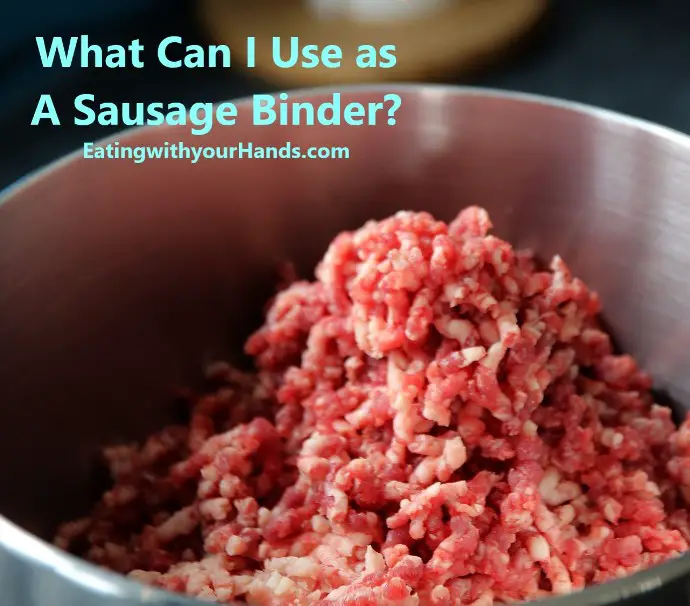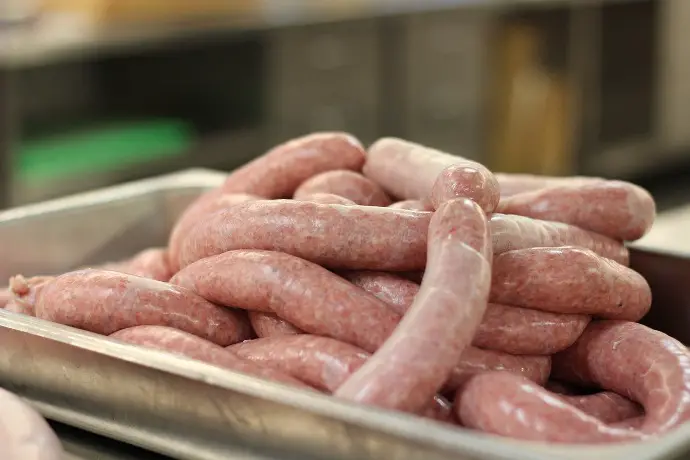Are you tired of dry, crumbly sausages that are difficult to slice and lacking in flavor? The secret to creating perfectly juicy and delicious sausages is using a sausage binder.
Binders are essential ingredients that help to improve the texture, moisture, and overall quality of sausages.
In this article, we will explore the various sausage binding agents that you can use to elevate your homemade sausages.

Table of Contents
- Sausage Binders: Enhancing the Quality of Your Sausages
- Are Sausage Binders Really Necessary for Homemade Sausage?
- Types of Sausage Binders: What Can You Use for Your Homemade Sausage?
- Soy Protein Concentrate: Great for Texture and Moisture Retention
- Dairy-Based Binders: Affordable and Moisture-Retaining
- Carrageenan Gum: Natural Extract for Excellent Texture
- Maltodextrin: Inexpensive and Gluten-Free
- Breadcrumbs as a Binder
- Carrot Fiber as a Binder
- Potato Starch as a Binder
- Mincing Meats in Different Grinders
- Conclusion
Sausage Binders: Enhancing the Quality of Your Sausages
Let’s talk about sausage binders and how they enhance the quality of your sausages.
What are Sausage Binders?
Sausage binders are additives that are used to improve the fat and moisture retention in sausages. They can also help mask off-flavors in sausages made from wild game, and are responsible for delivering the smoothness and consistency of the meat that makes sausages so enjoyable.
So, How do Sausage Binders Work?
They play a crucial role in the process of making sausages by promoting protein extraction, which is the process of breaking down muscle proteins in the meat.
This helps cover the fat particles and prevent them from clumping together. The binder’s affinity for water helps with even fat distribution, resulting in a juicy and flavorful sausage.
How Much Sausage Binder Should You Use?
When using sausage binders, it’s important to use a relatively low proportion – up to 2% of the meat’s weight. Using high-quality binders and performing thorough protein extraction will help the meat bind better to the sausage casing and prevent the migration of fat, also known as “fat-out.”
So, there you have it – sausage binders are a key ingredient in making delicious, juicy, and flavorful sausages.
>>Read more: How to Tie and Cut Sausage Links
Are Sausage Binders Really Necessary for Homemade Sausage?

Can you make homemade sausage without a binding agent and still get a juicy and delicious result? Let’s find out.
The Truth About Sausage Binders
To answer the question simply: no, sausage binders are not necessary to make homemade sausage. However, the use of binders ultimately boils down to personal preference.
Some people find that they can successfully retain moisture in their sausage without using a binder. Meanwhile, others swear by it and claim that it’s the only way to ensure consistency and juiciness in their sausage.
When it comes to sausage-making, one of the primary concerns is how to prevent the fat from rupturing the casing and squirting everywhere. This is where binders come in handy as they can act as insurance against this happening. With a binding agent, the meat mixture will hold together better and there’s less chance of fat leakage.
The Benefits of Using Sausage Binders
While sausage binders are not a must-have, they do have their benefits. One of the main advantages of using a binder is that it helps prevent the loss of volume in your sausage.
This means that your sausage will stay plump and juicy, even after cooking. A binder can also help to ensure more consistency in texture and flavor.
Another benefit of using a binder is that it can enhance the mouthfeel of your sausage. Binders like soy protein concentrate or non-fat dry milk powder can help to create a smoother texture and make the sausage feel less greasy in the mouth.
Ultimately, the decision to use a sausage binder is up to you. If you’re looking for insurance against fat leakage, more consistent texture, and juicier sausage, then using a binder is a good idea.
On the other hand, if you’re not concerned about these factors, then you can make homemade sausage without a binder and still get great flavor.
>>Read more about what are the black things in salami here!
Types of Sausage Binders: What Can You Use for Your Homemade Sausage?

Are you planning to make some homemade sausage? If so, you might be wondering what kind of binder to use to achieve that perfect texture, moisture retention, and smooth consistency. Let me break down some of the most popular options for you.
Soy Protein Concentrate: Great for Texture and Moisture Retention
First up, we have soy protein concentrate. It’s a fan favorite for home sausage production because it gives the sausage a great texture and helps it retain moisture.
This makes it an excellent choice for both smoked and cooked sausage. You’ll need about one cup of soy protein for every five pounds of meat, but keep in mind that it can be a bit pricier than some of the other options.
Dairy-Based Binders: Affordable and Moisture-Retaining
If you’re looking for a more affordable binder that still does a great job of retaining moisture, non-fat dry milk is an excellent choice. It’s particularly great for wild game sausages.
Another option is high-quality whey protein, but be sure to get the unflavored kind. Just keep in mind that these dairy-based binders might not be the best choice if you or anyone you’re making sausage for is lactose intolerant.
Carrageenan Gum: Natural Extract for Excellent Texture
Next up, we have carrageenan gum, which is a natural extract from red seaweed. This binder is particularly great for making skinless sausage because it ensures an excellent texture.
It absorbs a lot of water and traps it inside when heated, which increases volume and cooking yields. You only need about 1% of the meat’s weight to get the desired result.
Maltodextrin: Inexpensive and Gluten-Free
Last but not least, we have maltodextrin, which is an inexpensive and gluten-free option. It’s a white powder that is derived from rice, wheat, potato, or corn.
It’s a highly processed but safe food additive that’s easy to use. Even though it contains higher carbohydrate levels, you only need small amounts in sausage making. Just be aware that sausage made with maltodextrin might have a slightly rubbery texture.
Creative Binders for Sausage Making
Breadcrumbs as a Binder

Breadcrumbs are a classic binder used in sausage making for centuries. The crumbs help hold the meat together and prevent it from breaking apart while cooking. They also add some texture to the sausage, making it feel more substantial.
When using breadcrumbs as a binder, ensure that they are fresh and unseasoned. You can add seasoning to the sausage mixture separately.
Carrot Fiber as a Binder
Carrot fiber is a lesser-known option, but it can be an excellent alternative to breadcrumbs. It is an all-natural product made from carrot pulp and is high in fiber.
When added to sausage meat, it helps retain moisture, prevent shrinkage, and enhance texture. Carrot fiber is also gluten-free, making it a great option for those with dietary restrictions.
Potato Starch as a Binder
Potato starch is another great binder option that has been used in sausage-making for a long time. It helps the sausage hold together and maintains its shape when cooking.
Potato starch also provides a subtle flavor to the sausage and is gluten-free. When using potato starch, ensure that you dissolve it in cold water before adding it to the sausage mixture.
Mincing Meats in Different Grinders
Another way to achieve a perfect bind is by mincing the meats in different grinders. This technique works by breaking down the meat fibers in various sizes, which helps them interlock better.
For example, you can grind some of the meat through a coarse plate and the rest through a fine plate. Then, combine them to create a perfect blend that will hold together beautifully.
Conclusion
While the sausage binding agent may not be the most glamorous ingredient in a sausage recipe, it plays a vital role in creating the perfect texture, consistency, and moisture.
By using common ingredients like soy protein concentrate and non-fat dry milk, you can elevate your homemade sausage to the next level.
Don’t be afraid to experiment and try different binding agents to find your favorite combination.
Just be sure to use the appropriate amount and mix it thoroughly for the best results.

Fernando is the creator and writer behind the food blog Eating with your Hands. Living and working in cities like Paris, Barcelona, and Berlin, and being married to a Canadian foodie, has given Fernando a passion and interest in food and inspired him to run EWYH.
